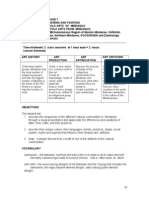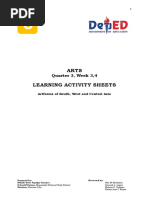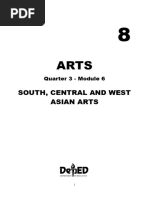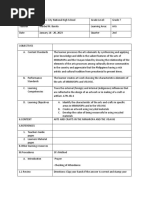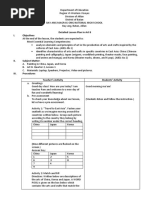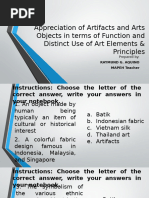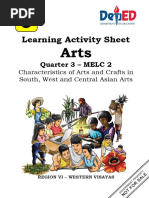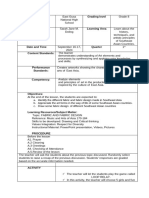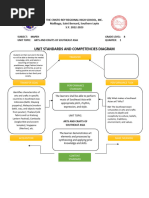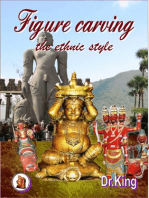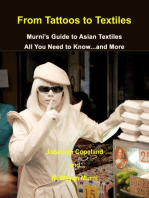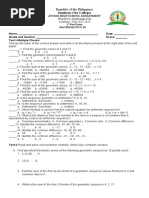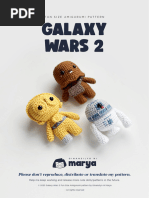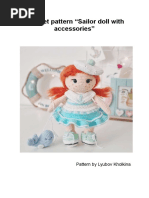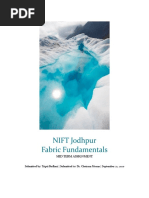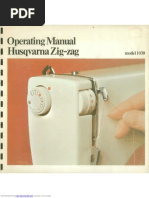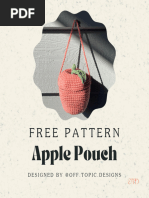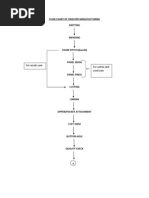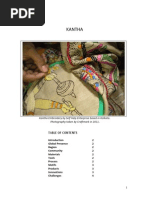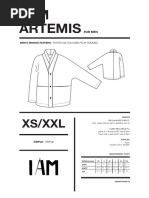G8-Arts-Q3 - WEEK 1
G8-Arts-Q3 - WEEK 1
Uploaded by
Ma'am Jayel Delos ReyesCopyright:
Available Formats
G8-Arts-Q3 - WEEK 1
G8-Arts-Q3 - WEEK 1
Uploaded by
Ma'am Jayel Delos ReyesOriginal Title
Copyright
Available Formats
Share this document
Did you find this document useful?
Is this content inappropriate?
Copyright:
Available Formats
G8-Arts-Q3 - WEEK 1
G8-Arts-Q3 - WEEK 1
Uploaded by
Ma'am Jayel Delos ReyesCopyright:
Available Formats
FOR ZAMBOANGA CITY DIVISION USE ONLY 1
NOT FOR SALE
8
MAPEH-ART
QUARTER 3-WEEK 1
CapSLET
Capsulized Self-Learning Empowerment Toolkit
SELF-LEARNING MATERIAL
Schools Division Office of Zamboanga City
Region IX, Zamboanga Peninsula
Zamboanga City
“No Hay Cosa, Imposible, Cree, Junto-Junto Puede!”
Developed by:
DARWIN D. HUETIRA EMMANUEL T. MAKINTA
Secondary School Teacher I Master Teacher I
Zamboanga National High School-West Zamboanga National High School-West
2
SUBJECT
MAPEH-
& GRADE QUARTER 3 WEEK 1 DAY ________________________________
ART 8 dd/mm/yyyy
LEVEL
TOPIC SOUTH, CENTRAL and WEST ASIA
Analyze elements and principles of art in the production of arts and
LEARNING crafts inspired by the cultures of South Asia, West Asia, and Central
COMPETEN-
CIES Asia.
(A8EL-IIIb-1)
IMPORTANT: Do not write anything on this material. Write your answers on the
Learner’s Activity and Assessment Sheets provided separately.
UNDERSTAND
In your previous lesson, you have learned about the different arts and crafts of
East Asia countries. Now, you are ready to analyze the elements and principles of
arts of these countries as seen in the different artworks.
Basic Characteristics
Art Forms
Design Colors
1. India
designs for decorating uses finely ground white
the courtyard of their powder along with different
house. colors.
Rangoli
2. Pakistan
painted with images of brightly colored flamboyant
idealized landscapes, trucks
famous personalities,
flowers, and trees,
turned village lanes, city
streets, and long-
distance highways into a
gallery without walls; a
free-form, kaleidoscopic
Track Art exhibition in motion.
“No Hay Cosa, Imposible, Cree, Junto-Junto Puede!”
Developed by:
DARWIN D. HUETIRA EMMANUEL T. MAKINTA
Secondary School Teacher I Master Teacher I
Zamboanga National High School-West Zamboanga National High School-West
3
3. Uzbekistan
Printed table-cloths, curtains,
Uzbekistan is known for bed-spreads, shawls and
making printed cloth. various coverlets were
utilitarian and served as a
daily-round ornament as well.
Printed Cloth
4. Turkmenistan
Turkmen carpets have The most unique and
been traditionally woven beautiful carpets. Carpet
out of wool, cotton, and weaving is an ancient art,
silk by women, using and each tribe developed its
horizontal looms. The own distinctive pattern.
method of weaving has
been modernized, but
the beauty and quality of
Turkmenistan Carpet the fabrics remain.
5. Kyrgyzstan
designs are chosen to
symbolize Kyrgyz Flowers, plants, animals,
traditions and rural life. stylized horns, national
designs, and emblems of
Kyrgyz life are often found in
these ornate and colorful
Tush kyiz embroideries.
Self-Assessment Question 1:
What are the colors used in fabric?
Self-Assessment Question 2:
What are the patterns/designs of Rangoli India in terms of lines and colors?
“No Hay Cosa, Imposible, Cree, Junto-Junto Puede!”
Developed by:
DARWIN D. HUETIRA EMMANUEL T. MAKINTA
Secondary School Teacher I Master Teacher I
Zamboanga National High School-West Zamboanga National High School-West
4
Let’s Practice!
It’s your turn now to put into practice what you have learned.
Directions: Analyzes elements and principles of art in the production of arts and crafts
inspired by the cultures of South, Central and West Asia. Read and understand the
statements carefully. Choose the letter of the correct answer.
_____1. What principle of art is shown in the given picture?
a. Alternating design
b. Repetition
c. Progression
d. Symmetrical
_____ 2. What type of line is emphasized in the picture?
a. Straight Line
b. Curve Line
c. Horizontal Line
d. Vertical Line
_____ 3. What principle of art is found in the picture?
a. Symmetrical balance
b. Asymmetrical balance
c. Alternating
d. Repetition
_____ 4. Which of the following principles of art is described in
Rangoli design?
a. Progression
b. Alternating
c. Repetition
d. Both A and B
_____ 5. What kind of lines are evident in Turkmen Carpet?
a. Curved lines
b. Straight lines
c. Horizontal lines
d. Vertical lines
“No Hay Cosa, Imposible, Cree, Junto-Junto Puede!”
Developed by:
DARWIN D. HUETIRA EMMANUEL T. MAKINTA
Secondary School Teacher I Master Teacher I
Zamboanga National High School-West Zamboanga National High School-West
5
REMEMBER
Key Points
Rangoli is one of the most beautiful and most pleasing art forms of India. It is
comprised of two words: 'rang' meaning 'color' and 'aavalli' meaning 'colored
creepers' or 'row of colors'.
Across Pakistan, brightly colored flamboyant trucks, painted with images of
idealized landscapes, famous personalities, flowers, and trees, turned village
lanes, city streets, and long-distance highways into a gallery without walls; a
free-form, kaleidoscopic exhibition in motion.
Uzbekistan ceramics hold a prominent place among the numerous forms of
popular applied art.
The most unique and beautiful carpets in the world are produced by
Turkmenistan. These vary in shape and purpose. Carpet weaving is an ancient
art, and each tribe developed its own distinctive pattern.
Large elaborately embroidered wall hangings called Tush kyiz are traditionally
made in Kyrgyzstan and Kazakhstan, by elder women to commemorate the
marriage of a son or daughter.
LET’S TRY
Let’s see how much have you learned.
Directions: Given the Rangoli from India picture below, make your own design of
Rangoli by using the elements and principles of arts of the said picture. Your will be
rated using the rubrics below.
Category Excellent Good Fair Poor
(5 PTS) (4 pts) (3 pts) (2 pts)
Element of Element of art Element of art Element of art There is no
Arts of Southeast of Southeast of Southeast visible element
Asian culture Asian culture Asian culture of art of
is well-defined is visible but is somewhat Southeast
& used from not clearly visible but not Asian culture
beginning to illustrated continuos
end
Creativity & Student’s Student’s Student’s Student’s
Workmanship output is very output is good output is fair & output is dull
creative & tidy & tidy has few errors with lots of
errors
Principles of Principle of art Principle of art Principle of art There is no
Arts of Southeast of Southeast of Southeast visible principle
Asian culture Asian culture Asian culture of art of
is well-defined is visible but is somewhat Southeast
& used from not clearly visible but not Asian culture
beginning to illustrated continuos
end
“No Hay Cosa, Imposible, Cree, Junto-Junto Puede!”
Developed by:
DARWIN D. HUETIRA EMMANUEL T. MAKINTA
Secondary School Teacher I Master Teacher I
Zamboanga National High School-West Zamboanga National High School-West
6
REFERENCES
Music and Arts of Southeast Asia Learning Material, Department of Education, Manila
Philippines pp.-244-270.
http://images.redstate.com/files/map9-middle-east-and-cent.gif
http://en.wikipedia.org/wiki/India
http://en.wikipedia.org/wiki/Central_Asia
http://www.google.com.ph/imgres?q=visual+art+from+india
http://www.britannica.com/EBchecked/topic/102315/history-of-Central-Asia
DISCLAIMER
This learning resource contains copyrighted materials. The use of which has
not been specifically authorized by the copyright owner. We are making this learning
resource in our efforts to provide printed and e-copy learning resources available for
the learners in reference to the learning continuity plan of this division in this time of
pandemic.
This LR is produced and distributed locally without profit and will be used for
educational purposes only. No malicious infringement is intended by the writer.
Credits and respect to the original creator/owner of the materials found in this learning
resource.
“No Hay Cosa, Imposible, Cree, Junto-Junto Puede!”
Developed by:
DARWIN D. HUETIRA EMMANUEL T. MAKINTA
Secondary School Teacher I Master Teacher I
Zamboanga National High School-West Zamboanga National High School-West
7
8
MAPEH-ART
QUARTER 3-WEEK 1
CapSLET
Capsulized Self-Learning Empowerment Toolkit
LEARNER’S ACTIVITY
AND ASSESSMENT SHEETS
“No Hay Cosa, Imposible, Cree, Junto-Junto Puede!”
Developed by:
DARWIN D. HUETIRA EMMANUEL T. MAKINTA
Secondary School Teacher I Master Teacher I
Zamboanga National High School-West Zamboanga National High School-West
8
Schools Division Office of Zamboanga City
Region IX, Zamboanga Peninsula
Zamboanga City
NAME: ____________________________________________ SECTION: _____________
SUBJECT
MAPEH-
& GRADE QUARTER 3 WEEK 1 DAY _______________________________
ART 8 dd/mm/yyyy
LEVEL
TOPIC SOUTHEAST ASIAN ARTS
LEARNING Analyze elements and principles of art in the production of arts and crafts
COMPETEN- inspired by the cultures of South Asia, West Asia, and Central Asia.
CIES (A8EL-IIIb-1)
UNDERSTAND
Self-Assessment Question 1: What are the colors used in fabric?
_______________________________________________________________
____________________________________________________________________
____________________________________________________________________
____________________________________________________________________
Self-Assessment Question 2: What are the patterns/designs of Rangoli India
in terms of lines and colors?
_______________________________________________________________
____________________________________________________________________
____________________________________________________________________
____________________________________________________________________
Let’s Practice!
It’s your turn now to put into practice what you have learned.
Directions: Analyzes elements and principles of art in the production of arts and crafts
inspired by the cultures of South, Central and West Asia. Read and understand the
statements carefully. Choose the letter of the correct answer.
_____1. What principle of art is shown in the given picture?
a. Alternating design
b. Repetition
c. Progression
d. Symmetrical
“No Hay Cosa, Imposible, Cree, Junto-Junto Puede!”
Developed by:
DARWIN D. HUETIRA EMMANUEL T. MAKINTA
Secondary School Teacher I Master Teacher I
Zamboanga National High School-West Zamboanga National High School-West
9
_____ 2. What type of line is emphasized in the picture?
a. Straight Line
b. Curve Line
c. Horizontal Line
d. Vertical Line
_____ 3. What principle of art is found in the picture?
a. Symmetrical balance
b. Asymmetrical balance
c. Alternating
d. Repetition
_____ 4. Which of the following principles of art is described in
Rangoli design?
a. Progression
b. Alternating
c. Repetition
d. Both A and B
_____ 5. What kind of lines are evident in Turkmen Carpet?
a. Curved lines
b. Straight lines
c. Horizontal lines
d. Vertical lines
LET’S TRY
Let’s see how much have you learned.
Directions: Given the Rangoli from India picture below, make your own design of
Rangoli by using the elements and principles of arts of the said picture. Your will be
rated using the rubrics below.
Category Excellent Good Fair Poor
(5 PTS) (4 pts) (3 pts) (2 pts)
Element of Element of art Element of art Element of art There is no
Arts of Southeast of Southeast of Southeast visible element
Asian culture is Asian culture Asian culture is of art of
well-defined & is visible but somewhat Southeast
used from not clearly visible but not Asian culture
beginning to illustrated continuos
end
“No Hay Cosa, Imposible, Cree, Junto-Junto Puede!”
Developed by:
DARWIN D. HUETIRA EMMANUEL T. MAKINTA
Secondary School Teacher I Master Teacher I
Zamboanga National High School-West Zamboanga National High School-West
10
Creativity & Student’s Student’s Student’s Student’s
Workmanship output is very output is good output is fair & output is dull
creative & tidy & tidy has few errors with lots of
errors
Principles of Principle of art Principle of art Principle of art There is no
Arts of Southeast of Southeast of Southeast visible principle
Asian culture is Asian culture Asian culture is of art of
well-defined & is visible but somewhat Southeast
used from not clearly visible but not Asian culture
beginning to illustrated continuos
end
“No Hay Cosa, Imposible, Cree, Junto-Junto Puede!”
Developed by:
DARWIN D. HUETIRA EMMANUEL T. MAKINTA
Secondary School Teacher I Master Teacher I
Zamboanga National High School-West Zamboanga National High School-West
11
MAPEH – ART 8
CapSLET QUARTER 3, WEEK 1
ANSWER KEY
PARTS/TOPICS ANSWERS
Self-Assessment Question 1
Self-Assessment Question 2
1. B
2. B
LET’S PRACTICE 3. A
4. C
5. A
LET’S TRY 15 POINTS
“No Hay Cosa, Imposible, Cree, Junto-Junto Puede!”
Developed by:
DARWIN D. HUETIRA EMMANUEL T. MAKINTA
Secondary School Teacher I Master Teacher I
Zamboanga National High School-West Zamboanga National High School-West
You might also like
- Husqvarna/Viking Platinum 715/735/755Document60 pagesHusqvarna/Viking Platinum 715/735/755iliiexpugnans100% (1)
- CRLA Narrative ReportDocument4 pagesCRLA Narrative ReportMa'am Jayel Delos Reyes100% (3)
- 7 Grade 7 Art, T.G. QTR 1, Mindanao Module 3, Les. 1 and 2 - AapDocument8 pages7 Grade 7 Art, T.G. QTR 1, Mindanao Module 3, Les. 1 and 2 - AapLen Vicente - Ferrer100% (3)
- Simple Slip Dress NestDocument5 pagesSimple Slip Dress NestAkira Kan100% (1)
- Garment InspectionDocument10 pagesGarment Inspectionsyed asim najam100% (7)
- Magic PotionsDocument16 pagesMagic PotionsRed SantosNo ratings yet
- Arts 8: Southeast Asian ArtDocument14 pagesArts 8: Southeast Asian ArtAizel Mae Consas /Amado HernandezNo ratings yet
- Arts Week 3&4Document7 pagesArts Week 3&4novem salonoyNo ratings yet
- Mapeh8 DLL Arts Q3 3Document5 pagesMapeh8 DLL Arts Q3 3Danielle DuplonNo ratings yet
- Alon Inggo Tua Semi Detailed Lesson PlanDocument3 pagesAlon Inggo Tua Semi Detailed Lesson PlanSaguiraNo ratings yet
- Arts-8 Module-1 Q 1-Final 01Document20 pagesArts-8 Module-1 Q 1-Final 01auroranhs24No ratings yet
- LAS2 - W3&4 - ARTS - 8 - Arts and Crafts of West and Central AsiaDocument5 pagesLAS2 - W3&4 - ARTS - 8 - Arts and Crafts of West and Central Asiaorbonharvey549No ratings yet
- Arts8 - q1 - Mod1 - Elements and Principles of Art and Crafts in Southeast Asia - FINAL08032020Document23 pagesArts8 - q1 - Mod1 - Elements and Principles of Art and Crafts in Southeast Asia - FINAL08032020HERNAN JAY BUYOKNo ratings yet
- Arts8 - q1 - Mod1 - Elements and Principles of Art and Crafts in Southeast Asia - FINAL08032020Document25 pagesArts8 - q1 - Mod1 - Elements and Principles of Art and Crafts in Southeast Asia - FINAL08032020Krizzia Brillantes50% (2)
- DLP-BEGASO-ARTS-Q3-Week1-D1Document5 pagesDLP-BEGASO-ARTS-Q3-Week1-D1seentro09 pjNo ratings yet
- February 21Document5 pagesFebruary 21Maria Richenette RallosNo ratings yet
- Quarter 1 - Module 1 Elements: and Principles of Arts and Crafts in Southeast AsiaDocument21 pagesQuarter 1 - Module 1 Elements: and Principles of Arts and Crafts in Southeast AsiaY u c k.100% (1)
- Week 3 Day 2 (Arts)Document4 pagesWeek 3 Day 2 (Arts)Ira Lael Boniao-JingcoNo ratings yet
- 5 Gr. 7 TG, QTR 1, Luzon Module .1, Lesson 1, 2, 3 - Aap FinalDocument3 pages5 Gr. 7 TG, QTR 1, Luzon Module .1, Lesson 1, 2, 3 - Aap FinalLen Vicente - Ferrer100% (1)
- Arts Southeast Asia Lesson1 g8 q1Document29 pagesArts Southeast Asia Lesson1 g8 q1Gie Dan50% (2)
- Quarter 3-Module 2: South, Central, and West Asian ArtsDocument8 pagesQuarter 3-Module 2: South, Central, and West Asian ArtsTuppal Alyssah NaomiNo ratings yet
- Quarter 3-Module 2: South, Central, and West Asian ArtsDocument8 pagesQuarter 3-Module 2: South, Central, and West Asian ArtsTuppal Alyssah NaomiNo ratings yet
- q1 Arts8 Lesson 1 and Crafts of Southeast AsiaDocument11 pagesq1 Arts8 Lesson 1 and Crafts of Southeast AsiaJoshua TamonNo ratings yet
- Q3 Arts8 M6 RevisedDocument11 pagesQ3 Arts8 M6 RevisedchingloycasicasNo ratings yet
- DLP Arts 8 Day 1Document4 pagesDLP Arts 8 Day 1Ira Lael Boniao-JingcoNo ratings yet
- MODULE IN ARTS 8 FinalDocument24 pagesMODULE IN ARTS 8 FinalMichelle CostalesNo ratings yet
- GRADE-7-Arts-and-Crafts-of-Luzon-HighlandsDocument31 pagesGRADE-7-Arts-and-Crafts-of-Luzon-HighlandsApple JanduganNo ratings yet
- DIVISION-SLM-CPAR-Q2-MODULE-13-studentDocument10 pagesDIVISION-SLM-CPAR-Q2-MODULE-13-studenttamondongjoananorieNo ratings yet
- 2nd QuarterDocument5 pages2nd QuarterMarbz M BellaNo ratings yet
- Detailed Lesson Plan in Art 8 I. ObjectivesDocument9 pagesDetailed Lesson Plan in Art 8 I. ObjectivesJohn Zedrick MercadoNo ratings yet
- Nov (16-30) ColourDocument132 pagesNov (16-30) ColourSasikalaNo ratings yet
- Arts 8 Q1 W1Document14 pagesArts 8 Q1 W1Kathrynnes AquinoNo ratings yet
- Schools Division of Zamboanga Del Norte Ubay National High School Labason Ii DistrictDocument3 pagesSchools Division of Zamboanga Del Norte Ubay National High School Labason Ii DistrictAndevie Balili IguanaNo ratings yet
- LAS Visual Art 1st Q w1-2 Sir ArneeDocument15 pagesLAS Visual Art 1st Q w1-2 Sir ArneePau De Vera QuindaraNo ratings yet
- LAS 3rd QTR ARTSDocument4 pagesLAS 3rd QTR ARTSJoevanie ManeroNo ratings yet
- Art Education: Quarter 3 - Module 1 South, Central and West AsiaDocument10 pagesArt Education: Quarter 3 - Module 1 South, Central and West AsiaFaith MandinNo ratings yet
- Quarter 1: Week 2 DATEDocument7 pagesQuarter 1: Week 2 DATELovely BalinoNo ratings yet
- ARTS8 Q3 LAS2 FinalDocument13 pagesARTS8 Q3 LAS2 FinalJose VillameroNo ratings yet
- Unit II East Asian Arts: Department of EducationDocument11 pagesUnit II East Asian Arts: Department of EducationjosskevynbonifacioNo ratings yet
- Arts - ModuleDocument24 pagesArts - ModuleRegie G. GalangNo ratings yet
- Arts and Crafts of Indonesia, Malaysia, BrunieDocument8 pagesArts and Crafts of Indonesia, Malaysia, BrunieJudy Ann MorilloNo ratings yet
- Lesson Plan For CNHSDocument4 pagesLesson Plan For CNHSAlberto Jr RosarioNo ratings yet
- ART 8 Learner's MaterialDocument66 pagesART 8 Learner's MaterialIan AtienzaNo ratings yet
- Grade 8: Worksheet No.1Document2 pagesGrade 8: Worksheet No.1Geraldine Wilson100% (1)
- Quarter 3 South, Central, and West AsiaDocument11 pagesQuarter 3 South, Central, and West Asianova rhea garciaNo ratings yet
- Arts 1st CO LPDocument7 pagesArts 1st CO LPRAQUEL C. BINGUANNo ratings yet
- Lesson Plan in ArtsDocument5 pagesLesson Plan in ArtsSarah Jane M. DolingNo ratings yet
- Q1 - Arts 8Document9 pagesQ1 - Arts 8Mary Cristine AnascoNo ratings yet
- G8 ARTS (Quarter 1 Module 1)Document44 pagesG8 ARTS (Quarter 1 Module 1)yani_06No ratings yet
- W7.-Grade-8-ARTS Q2 M7of8 v2Document26 pagesW7.-Grade-8-ARTS Q2 M7of8 v2Jarnel CabalsaNo ratings yet
- DLP 3rd Week 1 Day 2Document2 pagesDLP 3rd Week 1 Day 2seentro09 pjNo ratings yet
- Quarter 1 Module 1 Elements and Principles of Arts and Crafts in Southeast AsiaDocument15 pagesQuarter 1 Module 1 Elements and Principles of Arts and Crafts in Southeast AsiaEne RiNo ratings yet
- ARTS 8 1st QDocument14 pagesARTS 8 1st QPrincess Alloha BordeosNo ratings yet
- Arts-8-Q1Document5 pagesArts-8-Q1mitchikatsxNo ratings yet
- Mapeh: Learning Activity SheetDocument7 pagesMapeh: Learning Activity SheetK ManjaresNo ratings yet
- SDO Navotas Arts8 Q1 Lumped.fvDocument50 pagesSDO Navotas Arts8 Q1 Lumped.fvfilesvideo993No ratings yet
- M B. A S - H S (M) : Subject Area: MAPEH (ARTS)Document2 pagesM B. A S - H S (M) : Subject Area: MAPEH (ARTS)seentro09 pjNo ratings yet
- Arts8 Q3 Module8Document25 pagesArts8 Q3 Module8inah alejoNo ratings yet
- Arts 8 Q1 Module1aDocument14 pagesArts 8 Q1 Module1adave niAHNo ratings yet
- MAPEH 8 - Q-1 Week 4Document3 pagesMAPEH 8 - Q-1 Week 4joel cagaananNo ratings yet
- arts-7-week-1-2Document6 pagesarts-7-week-1-2John Henrick GarilaoNo ratings yet
- Write Your Answer in Each Activity in Your MAPEH NotebookDocument5 pagesWrite Your Answer in Each Activity in Your MAPEH NotebookbwahahaNo ratings yet
- From Tattoos to Textiles, Murni's Guide to Asian Textiles, All You Need to Know…And MoreFrom EverandFrom Tattoos to Textiles, Murni's Guide to Asian Textiles, All You Need to Know…And MoreRating: 4 out of 5 stars4/5 (1)
- ACCOMPLISHMENT REPORT FOR SY 2022-2023-School LibrariesDocument2 pagesACCOMPLISHMENT REPORT FOR SY 2022-2023-School LibrariesMa'am Jayel Delos Reyes100% (1)
- MUSIC G9-Q3-Week.1-FERNANDO, AYLENE-ANN N.Document12 pagesMUSIC G9-Q3-Week.1-FERNANDO, AYLENE-ANN N.Ma'am Jayel Delos ReyesNo ratings yet
- CRlA Narrative ReportDocument1 pageCRlA Narrative ReportMa'am Jayel Delos Reyes100% (1)
- Accomplishment Report For Sy 2022-2023 - Slrc-LatuanDocument2 pagesAccomplishment Report For Sy 2022-2023 - Slrc-LatuanMa'am Jayel Delos ReyesNo ratings yet
- G10-1ST Part Exam 4TH GradingDocument2 pagesG10-1ST Part Exam 4TH GradingMa'am Jayel Delos ReyesNo ratings yet
- G8-1ST Part Exam 4TH GradingDocument2 pagesG8-1ST Part Exam 4TH GradingMa'am Jayel Delos ReyesNo ratings yet
- Grade 7 3RD SummativeDocument3 pagesGrade 7 3RD SummativeMa'am Jayel Delos ReyesNo ratings yet
- G9-1ST Part Exam 4TH GradingDocument4 pagesG9-1ST Part Exam 4TH GradingMa'am Jayel Delos ReyesNo ratings yet
- Grade 7 4th Quarter Summative ExamDocument2 pagesGrade 7 4th Quarter Summative ExamMa'am Jayel Delos ReyesNo ratings yet
- G10-1st PART EXAM-FINAL 1st QUARTERDocument2 pagesG10-1st PART EXAM-FINAL 1st QUARTERMa'am Jayel Delos ReyesNo ratings yet
- G10-2NDPART EXAM-FINAL 1st QUARTERDocument3 pagesG10-2NDPART EXAM-FINAL 1st QUARTERMa'am Jayel Delos ReyesNo ratings yet
- G10-SUMMATIVE-EXAM-FINAL 2nd QUARTERDocument1 pageG10-SUMMATIVE-EXAM-FINAL 2nd QUARTERMa'am Jayel Delos ReyesNo ratings yet
- Random Trivia QuestionsDocument2 pagesRandom Trivia QuestionsMa'am Jayel Delos ReyesNo ratings yet
- Tiny Firefighter HatDocument5 pagesTiny Firefighter Hatimkailee123No ratings yet
- TESHURA EnglishDocument5 pagesTESHURA EnglishRdeS100% (2)
- Ginansilyo Ni Marya Mary Grace Pile Galaxy Wars 2 Fun Size 1Document16 pagesGinansilyo Ni Marya Mary Grace Pile Galaxy Wars 2 Fun Size 1xuongrongsapnohoa100% (5)
- Dressmaking G7 ExploDocument25 pagesDressmaking G7 ExploLESLIE ANN CONDANo ratings yet
- Sailor Doll With Accessories by Lyubov Kholkina Lubava Crochet PatternDocument14 pagesSailor Doll With Accessories by Lyubov Kholkina Lubava Crochet Patternmariset100% (3)
- NIFT Jodhpur Fabric Fundamentals: Mid Term AssignmentDocument36 pagesNIFT Jodhpur Fabric Fundamentals: Mid Term AssignmentTripti BadlaniNo ratings yet
- FREE Embroidery Pattern Starry Night 2013 Anna ScottDocument4 pagesFREE Embroidery Pattern Starry Night 2013 Anna ScottLisaNo ratings yet
- How To Make A Macrame Wristlet Keychain Step by STDocument50 pagesHow To Make A Macrame Wristlet Keychain Step by STNatalya CamachoNo ratings yet
- Bb9e Crochet PatternDocument3 pagesBb9e Crochet PatternDenisszia Gerocz100% (1)
- Zigzag 1030Document41 pagesZigzag 1030LidijaNo ratings yet
- Written For Smallest Size. If Changes Are Necessary For Larger Sizes The Instructions Will Be Written ThusDocument1 pageWritten For Smallest Size. If Changes Are Necessary For Larger Sizes The Instructions Will Be Written Thuslareen_9457No ratings yet
- Kids Wear PPT-1 (Knit & Woven) PDFDocument30 pagesKids Wear PPT-1 (Knit & Woven) PDFTanmoy DebnathNo ratings yet
- Chibi Totoro ToyDocument2 pagesChibi Totoro Toygalaxy5111No ratings yet
- Apple Pouch Pattern PDFDocument10 pagesApple Pouch Pattern PDFtherese.rose84No ratings yet
- RHK0140 015006MDocument3 pagesRHK0140 015006MPía VivancoNo ratings yet
- Kalle Giraf Nusseklud Us PDFDocument7 pagesKalle Giraf Nusseklud Us PDFSue JamiesonNo ratings yet
- Q3 PPT Arts7Document22 pagesQ3 PPT Arts7ralphNo ratings yet
- Compact Spinning System: What For ?Document12 pagesCompact Spinning System: What For ?ThilinaAbhayarathneNo ratings yet
- Flowchart and Manufacturing Process For Sweater ManufacturingDocument4 pagesFlowchart and Manufacturing Process For Sweater ManufacturingSiddhesh GautamNo ratings yet
- Easy Baby Hat Crochet Pattern Email Opt in Offer PDF 2Document3 pagesEasy Baby Hat Crochet Pattern Email Opt in Offer PDF 2scribdNo ratings yet
- AngelDocument10 pagesAngelNicole OlivaresNo ratings yet
- Kantha Extended DocumentationDocument4 pagesKantha Extended DocumentationGaurav BassiNo ratings yet
- Style # M1Fa236Xx3-2 Button Polo W/PrintDocument9 pagesStyle # M1Fa236Xx3-2 Button Polo W/PrintabcNo ratings yet
- ARTEMIS Sewing Process ENG 1Document3 pagesARTEMIS Sewing Process ENG 1aledabiwanNo ratings yet
- Chevron TopDocument8 pagesChevron Topnguyenhongv8No ratings yet
- Technical Vocational Education Identifying Hand Tools and Parts of Sewing MachineDocument33 pagesTechnical Vocational Education Identifying Hand Tools and Parts of Sewing MachineJohn Carlo SantiagoNo ratings yet


